Related Research Articles

Ralph Forbes was an English film and stage actor active in Britain and the United States.
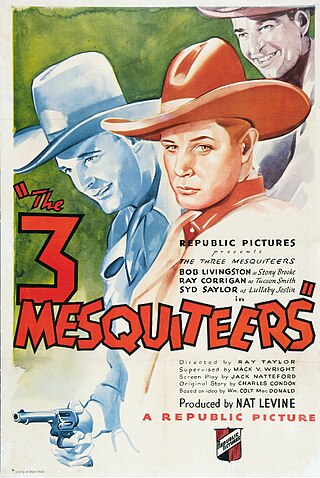
The Three Mesquiteers is the umbrella title for a Republic Pictures series of 51 American Western B-movies released between 1936 and 1943. The films, featuring a trio of Old West adventurers, was based on a series of Western novels by William Colt MacDonald. The eponymous trio, with occasional variations, were called Stony Brooke, Tucson Smith and Lullaby Joslin. John Wayne, who played Stony Brooke in eight of the films in 1938 and 1939, was the best-known actor in the series. Other leads included Bob Livingston, Ray "Crash" Corrigan, Max Terhune, Bob Steele, Rufe Davis and Tom Tyler.

Beau Ideal is a 1931 American pre-Code adventure film directed by Herbert Brenon and released by RKO Radio Pictures. The film was based on the 1927 adventure novel Beau Ideal by P. C. Wren, the third novel in a series of five novels based around the same characters. Brenon had directed the first in the series, Beau Geste, which was a very successful silent film in 1926. The screenplay was adapted from Wren's novel by Paul Schofield, who had also written the screenplay for the 1926 Beau Geste, with contributions from Elizabeth Meehan and Marie Halvey.

The Common Law is a 1931 American pre-Code romantic drama film directed by Paul L. Stein, produced by Charles R. Rogers and starring Constance Bennett and Joel McCrea. Based on Robert W. Chambers' 1911 novel of the same name, the film was the third film adaptation of the book, and the first during the sound-film era. It was received well both at the box office and by film critics, becoming one of RKO's most financially successful films of the year.

The Crime Doctor is a 1934 American crime drama directed by John Robertson from a screenplay by Jane Murfin, adapted from the novel The Big Bow Mystery by Israel Zangwill. The film stars Otto Kruger, Karen Morley, and Nils Asther. RKO Radio Pictures produced and distributed the film which was released on April 27, 1934.

Cockeyed Cavaliers is a 1934 American pre-Code comedy film starring the comedy duo of Wheeler & Woolsey. Directed by Mark Sandrich from a screenplay by Edward Kaufman, Grant Garrett, Ralph Spence and Ben Holmes. Also featured in the cast were Dorothy Lee and Thelma Todd.

Dangerous Corner is a 1934 American mystery film directed by Phil Rosen, using a screenplay by Anne Morrison Chapin, Madeleine Ruthven, Ralph Berton, and Eugene Berton, which was based on a novel and play of the same name by J. B. Priestley. It starred Virginia Bruce, Conrad Nagel, and Melvyn Douglas.

By Your Leave is a 1934 American domestic comedy film directed by Lloyd Corrigan from a script by Allan Scott, Lewis Foster, and Sam Mintz. The screenplay was based on a play of the same name by Gladys Hurlbut and Emma B. C. Wells, which had a short run early in the year at the Morosco Theatre. The film was produced by Pandro S. Berman, and starred Frank Morgan and Genevieve Tobin, although several other actresses were initially scheduled to appear in the film, including Mary Astor and Ann Harding. Both stars were on loan to RKO from other studios. It marked the film debuts of two notable Broadway actors, Glenn Anders and Gene Lockhart, the latter of which had a lengthy Hollywood career. By Your Leave opened on November 9, 1934, and received mostly positive reviews.

Gigolette is a 1935 American romance film directed by Charles Lamont from a screenplay and story by Gordon Kahn. The film stars Adrienne Ames, Ralph Bellamy, Donald Cook, and Robert Armstrong.

A Dog of Flanders is a 1935 American drama film directed by Edward Sloman, based on a screenplay by Ainsworth Morgan from the story by Dorothy Yost, which she adapted from the 1872 novel of the same name by Ouida. The film stars Frankie Thomas, appearing in only his second film.

Freckles is a 1935 American drama film directed by Edward Killy and William Hamilton from a screenplay written by Dorothy Yost, adapted by Mary Mayes from Gene Stratton-Porter's 1904 novel of the same name. Two earlier adaptations of Stratton-Porter's novel had been produced, the first by Paramount in 1917, and the second in 1928 by FBO, both were also titled Freckles. This 1935 version was released by RKO Radio Pictures on October 4, and stars Tom Brown, Virginia Weidler, and Carol Stone.

The Farmer in the Dell is a 1936 American comedy film directed by Ben Holmes from a screenplay by Sam Mintz and John Grey, adapted from Phil Stong's 1935 novel, which was similarly titled, Farmer in the Dell. The film was premiered by RKO Radio Pictures in New York City on March 6, 1936, and released widely later that month on March 27. It stars Fred Stone, Jean Parker, and Esther Dale.
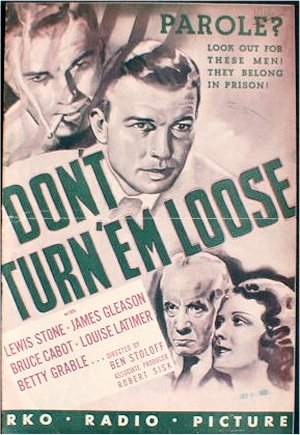
Don't Turn 'Em Loose is a 1936 American crime drama film directed by Ben Stoloff and produced by RKO Radio Pictures, who released the film on September 18, 1936. Written by Harry Segall and Ferdinand Reyher, the production's screenplay is at least partially based on "Homecoming" by Thomas Walsh, a short story published in Collier's magazine in March 1936. The film costars Lewis Stone, James Gleason, Bruce Cabot, Louise Latimer and Betty Grable.
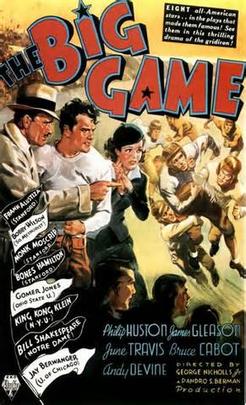
The Big Game is a 1936 American sports drama film directed by George Nicholls, Jr. and produced by RKO Radio Pictures, which released the film on October 9, 1936. The screenplay was written by Irwin Shaw, adapted from the 1936 novel of the same name by Francis Wallace. The film stars Philip Huston, James Gleason, June Travis, Bruce Cabot and Andy Devine. Huston (1908–1980) was a respected New York stage actor, who also had prominent roles in a number of motion pictures and, later, acted in television productions, as well.

China Passage is a 1937 American mystery film directed by Edward Killy from a screenplay by Edmund L. Hartmann and J. Robert Bren, based on a story by Taylor Caven. RKO Radio Pictures produced the film, which stars Constance Worth, Vinton Haworth, Leslie Fenton and Gordon Jones. Haworth was injured in an automobile accident in January 1937, delaying the film's released until March 12, 1937.
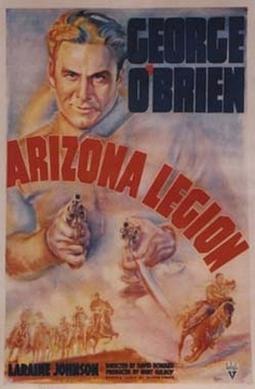
Arizona Legion is a 1939 American Western film directed by David Howard from a screenplay by Oliver Drake, based on Bernard McConville's story. Produced and distributed by RKO Radio Pictures, it was released on January 20, 1939, and stars George O'Brien and Laraine Day.
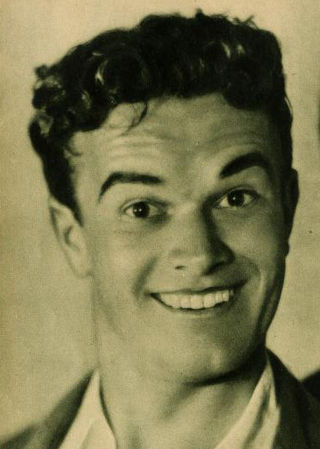
Nick Stuart was an Austro-Hungarian-born American actor and bandleader. His career spanned five decades, during which he appeared in over 50 films, more than half of them features, as well as film shorts, serials, and even one television appearance. He rose to stardom in such films as Girls Gone Wild and Chasing Through Europe, prior to expanding his business interests by creating a talent agency, and a popular upscale club in Hollywood.
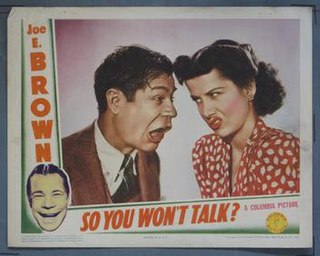
So You Won't Talk is a 1940 comedy directed by Edward Sedgwick, which stars Joe E. Brown in a dual role, along with Frances Robinson and Vivienne Osborne.

Behind the Mike is a 1937 American comedy film directed by Sidney Salkow, which stars William Gargan, Judith Barrett, Don Wilson, and Sterling Holloway. The screenplay was written by Barry Trivers from a story by Thomas Ahearn and Walton Butterfield. The film was released on September 26, 1937.

Wild Horse Range is a 1940 American Western film written by Carl Krusada from a story by Tom Gibson. It was directed by Raymond K. Johnson, and stars Jack Randall.
References
- ↑ "Shock". American Film Institute. Retrieved September 5, 2021.
- ↑ "Monogram to Start Work on Remaining 4 of Lineup". The Film Daily. April 10, 1934. p. 2. Retrieved September 6, 2021.

- ↑ "Mono Sets Six With English Casts Aimed Mostly at English Market". Variety. June 5, 1934. p. 4. Retrieved September 6, 2021.

- ↑ "Mono. Resumes Production". The Film Daily. May 15, 1934. p. 2. Retrieved September 6, 2021.

- ↑ Ralph Wilk (May 15, 1934). "A Little from "Lots"". The Film Daily. p. 6. Retrieved September 6, 2021.

- ↑ Ralph Wilk (May 16, 1934). "A Little from "Lots"". The Film Daily. p. 8. Retrieved September 6, 2021.

- ↑ Ralph Wilk (May 22, 1934). "A Little from "Lots"". The Film Daily. p. 5. Retrieved September 6, 2021.

- ↑ "Spot Contest Winner". Variety. May 15, 1934. p. 31. Retrieved September 6, 2021.

- ↑ "Studio Placements". Variety. May 22, 1934. p. 28. Retrieved September 6, 2021.

- ↑ "Studio Placements". Variety. May 29, 1934. p. 28. Retrieved September 6, 2021.

- ↑ "Mono, Men Pledge Double Sales Quotas". The Film Daily. May 29, 1934. p. 5. Retrieved September 6, 2021.

- ↑ "Latest News of Hollywood Scene: Eight New Films Launched". Motion Picture Herald. May 26, 1934. p. 36. Retrieved September 6, 2021.

- ↑ Victor M. Shapiro (June 9, 1934). "The Hollywood Scene". Motion Picture Herald. p. 33. Retrieved September 6, 2021.

- ↑ "Release Schedules for Features: Monogram Features". Harrison's Reports. August 18, 1934. p. 107. Retrieved September 6, 2021.

- ↑ "Shock—Monogram". Photoplay. October 1934. p. 96. Retrieved September 6, 2021.

- ↑ "Showmen's Reviews:Shock". Motion Picture Herald. July 28, 1934. p. 45. Retrieved September 6, 2021.

- ↑ "Looking 'Em Over:Shock". Motion Picture Daily. July 27, 1934. p. 6. Retrieved September 6, 2021.

- ↑ ""Shock" With Ralph Forbes, Gwenllian Gill and Monroe Owsley". Harrison's Reports. August 4, 1934. p. 123. Retrieved September 6, 2021.

- ↑ "Reviews of the New Features:"Shock"". The Film Daily. July 24, 1934. p. 8. Retrieved September 6, 2021.
